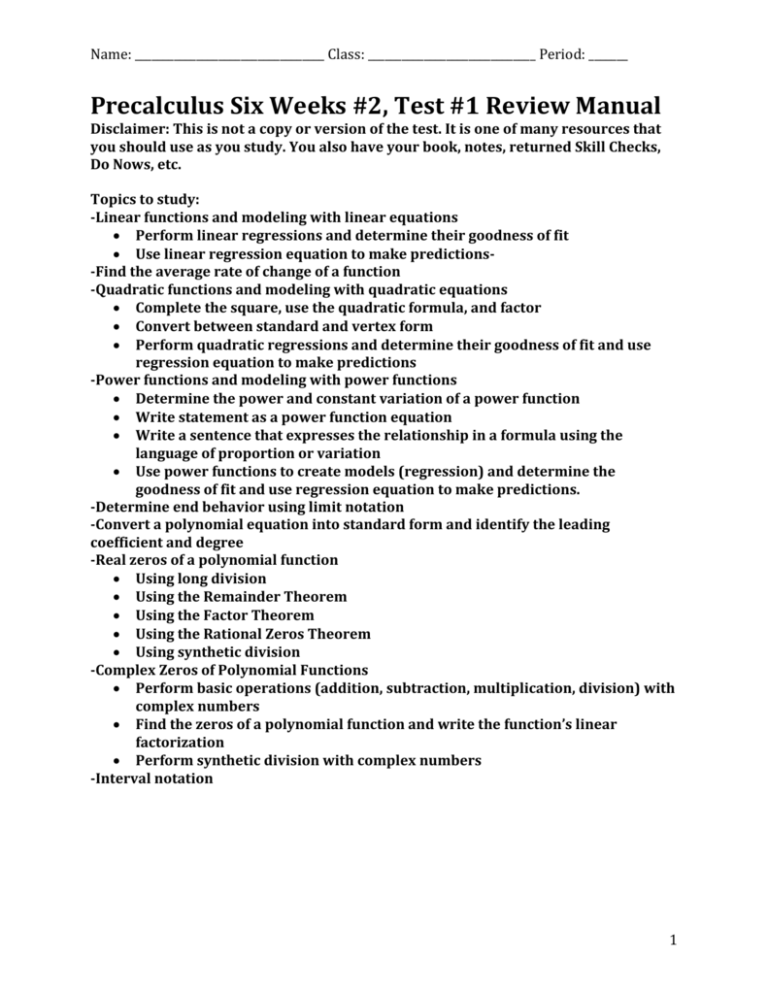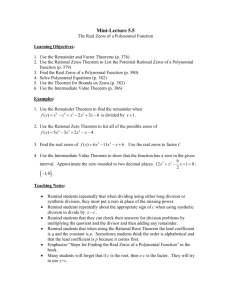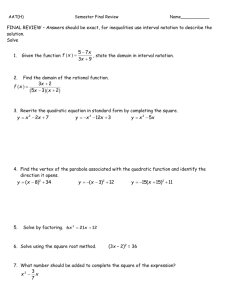b. - WordPress.com
advertisement

Name: __________________________________ Class: ______________________________ Period: _______ Precalculus Six Weeks #2, Test #1 Review Manual Disclaimer: This is not a copy or version of the test. It is one of many resources that you should use as you study. You also have your book, notes, returned Skill Checks, Do Nows, etc. Topics to study: -Linear functions and modeling with linear equations Perform linear regressions and determine their goodness of fit Use linear regression equation to make predictions-Find the average rate of change of a function -Quadratic functions and modeling with quadratic equations Complete the square, use the quadratic formula, and factor Convert between standard and vertex form Perform quadratic regressions and determine their goodness of fit and use regression equation to make predictions -Power functions and modeling with power functions Determine the power and constant variation of a power function Write statement as a power function equation Write a sentence that expresses the relationship in a formula using the language of proportion or variation Use power functions to create models (regression) and determine the goodness of fit and use regression equation to make predictions. -Determine end behavior using limit notation -Convert a polynomial equation into standard form and identify the leading coefficient and degree -Real zeros of a polynomial function Using long division Using the Remainder Theorem Using the Factor Theorem Using the Rational Zeros Theorem Using synthetic division -Complex Zeros of Polynomial Functions Perform basic operations (addition, subtraction, multiplication, division) with complex numbers Find the zeros of a polynomial function and write the function’s linear factorization Perform synthetic division with complex numbers -Interval notation 1 Name: __________________________________ Class: ______________________________ Period: _______ 1. Determine how to transform 𝒇(𝒙) = 𝒙𝟐 into the graph of the given function. Sketch the graph by hand using graph paper and support your answer with a grapher. a. 𝒉(𝒙) = 𝟑(𝒙 − 𝟐)𝟐 + 𝟒 b. 𝒈(𝒙) = −(𝒙 + 𝟑)𝟐 + 𝟏 a. Vertical stretch by a factor of 3. Translate right 2 and up 4. b. Reflected over the x-axis, translated up 1 and left 3. 2. Find the vertex and axis of the graph of the function. Support your answer by sketching the graph. a. 𝒇(𝒙) = −𝟐(𝒙 + 𝟑)𝟐 + 𝟓 b. 𝒈(𝒙) = 𝟒(𝒙 − 𝟓)𝟐 − 𝟕 c. 𝒇(𝒙) = −𝟐𝒙𝟐 − 𝟏𝟔𝒙 − 𝟑𝟏 d. 𝒈(𝒙) = 𝟑𝒙𝟐 − 𝟔𝒙 + 𝟐 a. Vertex at (-3, 5) axis at x = -3 b. Vertex at (5,-7) axis at x = 5 c. Vertex at (-4, 1) axis at x = -4 d. Vertex at (1, -1) axis at x = 1 3. Write an equation for the quadratic function whose graph contains the given vertex and point. a. Vertex (–2,–3), point (1,2) b. Vertex (–1,1), point (3, –2) 𝟓 a. 𝒇(𝒙) = 𝟗 (𝒙 + 𝟐)𝟐 − 𝟑 b. 𝒇(𝒙) = −𝟑 𝟏𝟔 (𝒙 + 𝟏)𝟐 + 𝟏 4. Write the statement as a power function equation. Let k be the constant of variation. a. The surface area S of a sphere varies directly as the square of the radius r. b. The force of gravity F acting on an object is inversely proportional to the square of the distance d from the object to the center of the earth. a. 𝑺 = 𝒌𝒓𝟐 𝒌 b. 𝑭 = 𝒅𝟐 5. Write a sentence that expresses the relationship in the formula, using the language of variation and proportion. a. F = kx, where F is the force it takes to stretch a spring x units from its unstressed length and k is the spring’s force constant. b. 𝑨 = 𝝅𝒓𝟐, where A is the area and r is the radius of a circle. a. The force it takes to stretch a spring varies proportionally with its unstressed length. b. The area of a circle varies directly with the square of the radius. 6. Describe the graph of the following power functions WITHOUT a graph. What is the power and constant of variation? Is the function even, odd, or neither? Does the graph have any zeros? 𝟏 a. 𝒇(𝒙) = 𝟒𝒙 ⁄𝟑 b. 𝒇(𝒙) = −𝟐𝒙−𝟑 a. Power Constant: 1/3, Constant of variation: 4, Odd, zero at (0,0). 2 Name: __________________________________ Class: ______________________________ Period: _______ b. Power Constant: -3, Constant of variation: -2, odd, No zeros. 8. Divide f(x) by d(x) using long division, and write a summary statement in polynomial and fraction form. a. 𝒇(𝒙) = 𝟐𝒙𝟒 − 𝟑𝒙𝟑 + 𝟗𝒙𝟐 − 𝟏𝟒𝒙 + 𝟕; 𝒙𝟐 + 𝟒 b. 𝒇(𝒙) = 𝟑𝒙𝟒 − 𝟓𝒙𝟑 − 𝟐𝒙𝟐 + 𝟑𝒙 − 𝟔; 𝒅(𝒙) = 𝟑𝒙 + 𝟏 a. Polynomial form: 𝒇(𝒙) = (𝟐𝒙𝟐 − 𝟑𝒙 + 𝟏)(𝒙𝟐 + 𝟒) + 𝟑 − 𝟐𝒙 𝒇(𝒙) 𝟑−𝟐𝒙 Fraction form: 𝒙𝟐 +𝟒 = 𝟐𝒙𝟐 − 𝟑𝒙 + 𝟏 + 𝒙𝟐 +𝟒 b. Polynomial form: 𝒇(𝒙) = (𝒙𝟑 − 𝟐𝒙𝟐 + 𝟏)(𝟑𝒙 + 𝟏) − 𝟕 𝒇(𝒙) 𝟕 Fraction form: 𝟑𝒙+𝟏 = 𝒙𝟑 − 𝟐𝒙𝟐 + 𝟏 − 𝟑𝒙+𝟏 9. Divide f(x) by d(x) using synthetic division, and write a summary statement in polynomial and fraction form. a. 𝒇(𝒙) = 𝟐𝒙𝟑 − 𝟕𝒙𝟐 + 𝟒𝒙 − 𝟓; 𝒅(𝒙) = 𝒙 − 𝟑 b. 𝒇(𝒙) = 𝒙𝟒 + 𝟑𝒙𝟑 + 𝒙𝟐 − 𝟑𝒙 + 𝟑; 𝒅(𝒙) = 𝒙 + 𝟐 a. Polynomial form: 𝒇(𝒙) = (𝟐𝒙𝟐 − 𝒙 + 𝟏)(𝒙 − 𝟑) − 𝟐 𝒇(𝒙) 𝟐 Fraction form: 𝒙−𝟑 = 𝟐𝒙𝟐 − 𝒙 + 𝟏 − 𝒙−𝟑 b. Polynomial form: 𝒇(𝒙) = (𝒙𝟑 + 𝒙𝟐 − 𝒙 − 𝟏)(𝒙 + 𝟐) + 𝟓 𝒇(𝒙) 𝟓 Fraction: 𝒙+𝟐 = 𝒙𝟑 + 𝒙𝟐 − 𝒙 − 𝟏 + 𝒙+𝟐 10. Use the Remainder Theorem to find the remainder when f(x) is divided by x–k. Check by using synthetic division. a. 𝑓(𝑥) = 3𝑥 3 − 2𝑥 2 + 𝑥; 𝑘 = −2 b. 𝑓(𝑥) = −𝑥 2 + 4𝑥 − 5; 𝑘 = 3 a. -39 b. -2 12. Use the Factor Theorem to determine whether the first polynomial is a factor of the second polynomial. a. 𝑥 − 2; 𝑥 3 − 4𝑥 2 + 8𝑥 − 8 b. 𝑥 + 3; 𝑥 3 + 2𝑥 2 − 4𝑥 − 2 a. Yes b. No 13. Use the Rational Zeros Theorem to write a list of potential rational zeros. Then determine which ones, if any, are zeros. a. 𝑓(𝑥) = 2𝑥 4 − 𝑥 3 − 4𝑥 2 − 𝑥 − 6 b. 𝑓(𝑥) = 6𝑥 3 − 20𝑥 2 + 11𝑥 + 7 a. Potential zeros: –1, 1, 6, –6, 3, –3, 2, –2, ½, –1/2, 3/2, –3/2 Rational Zeros: x = –3/2, 2 b. Potential zeros: 1, –1, 7, –7, 7/2, –7/2, 7/3, –7/3, 7/6, –7/6 Rational Zeros: 7/3 3 Name: __________________________________ Class: ______________________________ Period: _______ 14. Perform the indicate operation, and write the result in the form a+bi. a. (1 + 𝑖)3 c. (1 + 2𝑖)2 (1 − 2𝑖)2 b. 𝑖 29 d. √−16 a. –2+2i b. i c. 25 d. 4i 15. Find all the real zeros of the function. State the number of nonreal complex zeros. a. 𝑓(𝑥) = 𝑥 4 − 10𝑥 3 + 23𝑥 2 b. 𝑓(𝑥) = 𝑥 3 − 2𝑥 2 − 8𝑥 + 5 a. Rational: 0. Irrational, 5 ± √2. No nonreal zeros. b. Rational: None. Irrational: Approximately -2.34, .57, 3.77. No nonreal zeros. 16. Find all of the zeros and write a linear factorization of the function. a. 𝑓(𝑥) = 2𝑥 3 − 9𝑥 2 + 2𝑥 + 30 b. 𝑓(𝑥) = 5𝑥 3 − 24𝑥 + 𝑥 + 12 a. Zeros: 1, –1, 2/3, –5/2 𝑓(𝑥) = (3𝑥 − 2)(2𝑥 + 5)(𝑥 − 1)(𝑥 + 1) b. Zeros: 4/5, 2 ± √7 𝑓(𝑥) = (5𝑥 − 4)(𝑥 − 2 − √7)(𝑥 − 2 + √7) 17. Write the function as a product of linear and irreducible quadratic functions all with real coefficients. a. 𝑓(𝑥) = 𝑥 3 − 𝑥 2 − 𝑥 − 2 b. 𝑓(𝑥) = 9𝑥 3 − 3𝑥 2 − 13𝑥 − 1 a. 𝑓(𝑥) = (𝑥 − 2)(𝑥 2 + 𝑥 + 1) b. 𝑓(𝑥) = (𝑥 + 1)(9𝑥 2 − 12𝑥 − 1) 18. Write a polynomial function with real coefficients whose zeros and their multiplicities include those listed. a. Degree 3; zeros: √5, −√5, 3 b. Degree 2;–3 only real zero c. Degree 3; zeros: 1 + 𝑖, 2 a. 𝑓(𝑥) = 𝑥 3 − 3𝑥 2 − 5𝑥 + 15 b. 𝑓(𝑥) = 𝑥 2 + 6𝑥 + 9 c. 𝑓(𝑥) = 𝑥 3 − 4𝑥 2 + 6𝑥 − 4 4 Name: __________________________________ Class: ______________________________ Period: _______ 184 CHAPTER 2 Poly n om ial, Pow er, an d Rat ion al Fu n ct ion s 19. Linear regression: 53. Table 2.6 shows the average hourly compensation of production workers in manufacturing for several years. Let x be the number of years since 1970, so that x 5 stands for 1975, and so forth. Table 2.6 Production Worke r Av e rag e Year Hourly Compensation (dollars) 1975 1985 1995 2002 6.36 13.01 17.19 21.37 Sou rce: U.S. Bu reau of Lab or St at ist ics as rep ort ed in T h e W orld A lm an ac an d Book of Fact s, 2005. (a) Writin g to Learn Find the linear regression model for the data. What does the slope in the regression model represent? (b) Use the linear regression model to predict the production worker average hourly compensation in the year 2010. 54. Fin din g Max im um Are a Among all the rectangles whose perimeters are 100 ft, find the dimensions of the one with maximum area. 25 25 ft a. 𝑓(𝑥) = .541𝑥 + 4.072. The slope 55. De te rm in in g Re v e n ue The per unit price p (in dollars) of a tells that(inhourly compensation popular toy whenus x units thousands) are produced is modeled for production workers increases by the function about price 54 cents p per 12 year. 0.025x. b. About $25.70 The revenue (in thousands of dollars) is the product of the price per unit and the number of units (in thousands) produced. That is, revenue xp x 12 0.025x . (a) State the dimensions of a viewing window that shows a graph of the revenue model for producing 0 to 100,000 units. (b) How many units should be produced if the total revenue is to be $1,000,000? either 107,335 units or 372,665 units 56. Fin din g the Dim e n s ion s of a Pain tin g A large painting in the style of Rubens is 3 ft longer than it is wide. If the wooden frame is 12 in. wide, the area of the picture and frame is 208 ft2, find the dimensions of the painting. 11 ft by 14 ft 57. Us in g Alg e bra in Lan ds cape De s ig n Julie Stone designed a rectangular that is 25 ft by 40 ft. This patio is surrounded 21. Powerpatio Regression by a terraced strip of uniform planted with small trees and b. 𝑓(𝑥) = 7.932𝑥 −1.987width , yes. shrubs. If the area A of this terraced strip is 504 ft2, find the width x of the strip. 3.5 ft 58. Man ag e m e n t Plan n in g The Welcome Home apartment rental company has 1600 units available, of which 800 are currently rented at $300 per month. A market survey indicates that each $5 decrease in monthly rent will result in 20 new leases. (a) Determine a function R x that models the total rental income realized by Welcome Home, where x is the number of $5 decreases in monthly rent. R(x) (800 20x)(300 5x) (b) Find a graph of R x for rent levels between $175 and $300 (that is, 0 x 25) that clearly shows a maximum for R x . (c) What rent will yield Welcome Home the maximum monthly income? $250 per month 59. Group Activity Beverage Business The Sweet Drip Beverage Co. sells cans of soda pop in machines. It finds that sales average 26,000 cans per month when the cans sell for 50¢ each. For each nickel increase in the price, the sales per month drop by 1000 cans. (a) Determine a function R x that models the total revenue realized by Sweet Drip, where x is the number of $0.05 increases in the price of a can. R(x) (26,000 1000x)(0.50 0.05x) (b) Find a graph of R x that clearly shows a maximum for R x . (c) How much should Sweet Drip charge per can to realize the maximum revenue? What is the maximum revenue? 60. Group Activity Sales Manager Plan n in g Jack was named District Manager of the Month at the Sylvania Wire Co. due to his hiring study. It shows that each of the 30 salespersons he supervises average $50,000 in sales each month, and that for each additional salesperson he would hire, the average sales would decrease $1000 per month. Jack concluded his study by suggesting a number of b. Use the regression to hire predict the sales. What was that salespersons that he should to maximize amount of Pell number? 10 Grants in 2006 61. Fre e -Fall Motion As a promotion for the Houston Astros 2 ballpark, a competition is held to+ see who can throw a a.downtown 𝑓(𝑥) = 18.694𝑥 − 88.144𝑥 baseball the highest from the front row of the upper deck of seats, 2393.0222 83 ft above field level. The winner throws the ball with an initial b.vertical $5768 velocity of 92 ft/sec and it lands on the infield grass. (a) Find the maximum height of the base ball. (b) How much time is the ball in the air? About 6.54 sec (c) Determine its vertical velocity when it hits the ground. 62. Bas e ball Throw in g Machin e The Sandusky Little League uses a baseball throwing machine to help train 10-year-old players to catch high pop-ups. It throws the baseball straight up with an initial velocity of 48 ft/sec from a height of 3.5 ft. (a) Find an equation that models the height of the ball t seconds after it is thrown. h 16t 2 48t 3.5 (b) What is the maximum height the baseball will reach? How many seconds will it take to reach that height? 39.5 ft, 1.5 sec 5








